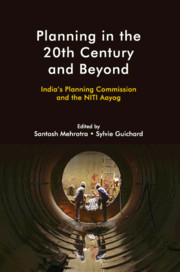Book contents
- Frontmatter
- Contents
- List of Figures
- List of Tables
- List of Abbreviations
- 1 Planning for a 21st Century India
- Part I Origins: Ideas and Ideology
- 2 From Economists to Historians: Studying the Planning Commission, 1950–2014
- 3 The Long Road to Indian Economic Planning (until 1950)
- 4 Ideas and Origins of the Planning Commission in India
- Part II Changes and Continuity: Development and Adaptation of Planning and the Planning Commission
- 5 The Planning Commission and Education
- 6 Addressing Agrarian Distress: Sops versus Development
- 7 Economic Planning after Economic Liberalization: Between Planning Commission and Think Tank NITI, 1991–2015
- 8 Planning Commission: Obiter Dictum
- 9 On a Revived Planning Commission
- Part III Planning Beyond the Planning Commission
- 10 Make in India
- 11 Manufacturing: The Cornerstone of a Planning Strategy for the 21st Century
- 12 Fiscal Planning to Sustain Growth and Poverty Reduction
- 13 Plan, but Do Not Over-plan: Lessons for NITI Aayog
- 14 Why Does India Need a Central Planning Institution in the 21st Century?
- Notes on Contributors
- Index
- References
14 - Why Does India Need a Central Planning Institution in the 21st Century?
Published online by Cambridge University Press: 04 April 2020
- Frontmatter
- Contents
- List of Figures
- List of Tables
- List of Abbreviations
- 1 Planning for a 21st Century India
- Part I Origins: Ideas and Ideology
- 2 From Economists to Historians: Studying the Planning Commission, 1950–2014
- 3 The Long Road to Indian Economic Planning (until 1950)
- 4 Ideas and Origins of the Planning Commission in India
- Part II Changes and Continuity: Development and Adaptation of Planning and the Planning Commission
- 5 The Planning Commission and Education
- 6 Addressing Agrarian Distress: Sops versus Development
- 7 Economic Planning after Economic Liberalization: Between Planning Commission and Think Tank NITI, 1991–2015
- 8 Planning Commission: Obiter Dictum
- 9 On a Revived Planning Commission
- Part III Planning Beyond the Planning Commission
- 10 Make in India
- 11 Manufacturing: The Cornerstone of a Planning Strategy for the 21st Century
- 12 Fiscal Planning to Sustain Growth and Poverty Reduction
- 13 Plan, but Do Not Over-plan: Lessons for NITI Aayog
- 14 Why Does India Need a Central Planning Institution in the 21st Century?
- Notes on Contributors
- Index
- References
Summary
The question ‘Does India need central planning?’ should be answered at both theoretical and empirical levels. This question requires to be answered because, when the Indian Planning Commission (PC) was disbanded and its concomitant five-year plans abandoned at the end of 2014, there was little substantive reasoning why this was done.
Economists who have some sense of the historical evolution of institutions (for example, the market and the state) in the now industrialized countries (all capitalist) know that laissez-faire in the economy/society never really existed anywhere, ever. There actually is no economy in the world that is not ‘planned’, to a smaller or greater degree (see Chapter 1 in this volume for more on this argument).
This chapter has three sections. The first section addresses the question above and discusses the theoretical and empirical arguments why planning is still needed in India. The next section discusses the functions that the erstwhile PC performed, what the current National Institution for Transforming India (NITI) does, and what should be the possible functions of a planning institution in a country the size of India in a rapidly globalizing economy. The final section examines how the planning function in India should be structured in terms of organization and human resources for effective functioning.
Why Planning? The Theoretical and Historical Argument
The market economy in the currently industrialized countries would not have come into existence but for the state; the state was critical in establishing key institutions of the market economy – land and labour were two such factors of production (Polanyi 1944). In the United Kingdom, the state was responsible for bringing land into the market economy through its programme of enclosing common land; thereby, it also set in motion a process which ultimately led to the creation of a national market for labour (Moore 1968).
While the Industrial Revolution began in England in the last quarter of the 18th century, it can hardly be said that an integrated national economic system existed until the second quarter of the 19th century. No market economy was conceivable that did not include a market for labour; but to establish such a market, especially in England's rural civilization, a complete transformation of the traditional fabric of society was needed.
- Type
- Chapter
- Information
- Planning in the 20th Century and BeyondIndia's Planning Commission and the NITI Aayog, pp. 283 - 317Publisher: Cambridge University PressPrint publication year: 2020
References
- 1
- Cited by



